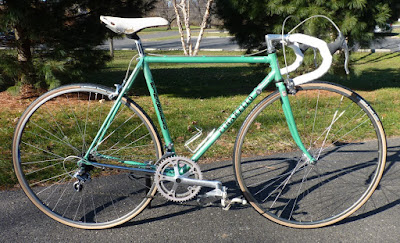Last night Sue and I got together with our
friends Matt and Ryan to “Cycle with Santa”, although it was only in a symbolic
sense, as St. Nick is simply too busy this time of year, and none of us
wanted to lug around the weight of a full costume! I think we might have
appreciated the warmth of his fur suit though, as the temperature was in the high thirties when we started and was dropping quickly.
With our bikes festooned (I like that word)
with lights, we set off just after dinner to meet the guys at Matt’s house,
about an 8-mile ride. The plan was to loop down the Perkiomen Trail from
Schwenksville to Oaks, then link up with the Schuylkill Trail through
Phoenixville to return to our home in Royersford – in total, about 30 miles for
Sue and I. We could then grab something warm to drink and put the guys’ bikes
in the back of our van to shuttle them back home.
Well, it was a good plan...
Along the ride there, I was nearly taken out
by a raccoon the size of a Labrador retriever, and a few miles later two huge
deer crossed the road just a couple of feet off my front wheel. Another pair of deer scampered out in front of me later on, and although the speed/weight/asphalt involved in those collisions
had potential for a higher degree of pain, the most dangerous proved to be a
rabbit on the trail that almost went under my wheels – only because I didn’t see or hear it
coming and had no time to react at all. I’ll move on quickly from mentioning
these incidents, as other than bursts of adrenaline, nothing really happened,
and I’d rather not dwell on what could
have!
We were pleased to see that Matt and Ryan
were in the spirit of the season by having both of their bikes decked with
string lights. Ryan looked at his three companions and mentioned (correctly, as
it turns out) that perhaps he was underdressed, then added that we should take
a picture. Sue commented that our son Colin could take a photo when we reached
Royersford – again, that was a good plan...
The temperature had dropped about ten
degrees since we had left from home, and I have to admit that, although my core
temp was comfortable, my hands and feet were already a bit chilly, and any
warmth that remained in them was gone completely
when we finished the long descent from Matt’s house down to the Perkiomen Trail
along its namesake creek. I’m usually hammering it by myself and get plenty
warm, but it was clear early on that the more casual pace wasn’t going to work
out well for my appendages.
I wasn’t going to let it get to me, and the miles
were passing fairly easily with plenty of lively conversation about our
children and Christmas plans. When I started slapping my numb hands together
and complained a bit, the others joked about what it might take for me to
actually quit a ride. “Not gonna happen, folks!” I quickly offered.
When we reached Collegeville (about halfway
for the Larimer riders), I did consider stopping at the diner there to warm up,
but everyone seemed okay, so I just plowed on. However, we weren’t really aware
about how bad Ryan was suffering, and maybe our chatter had been keeping his
mind off of the pain, too. Just before reaching the junction with the
Schuylkill Trail, where there was another downhill section to increase the
chill, he became noticeably quiet.
There were still about ten miles to go, and whatever
talk that still existed started turning to where we might be able to stop in
Phoenixville to warm up. Unfortunately, it became evident that Ryan’s enthusiasm to
continue beyond that point was very low. I knew that, as far as warming myself,
it was only a matter of getting the heart rate going – just contending with the
nasty hill over Phoenixville’s west side would do it – and I offered to dash
home the last five miles to grab the “rescue van”.
Sue definitely
wanted to finish, so we left the guys to the comfortable foyer of Molly Maguire’s
Pub and off we went. Strangely we both had issues with our bike lamps on the
last very dark stretch of trail towards Spring City and wondered if it was so
cold that our LEDs had actually frozen, but we negotiated our way safely home.
As I pulled up in front of the pub, it was obvious Ryan had thawed out, as I was greeted with a big smile and a wave. He and
Matt expressed disappointment in not being able to finish as they loaded their
bike in the back of our Honda Odyssey. When we reached Schwenksville, and I
turned into Matt’s driveway, Ryan joked about being “shamed by his elder” on
this ride (I have about twelve years on him) - perhaps he should feel worse
about being shamed by an elder girl!
 |
| The only bike-with-lights shot we ended up getting...mine. |
I’m going to take a few weeks off from
writing, with the coming of the holidays, but I’ll be back mid-January with
photos of progress and hopefully finished projects. Merry Christmas and Happy
New Year to all!


























































